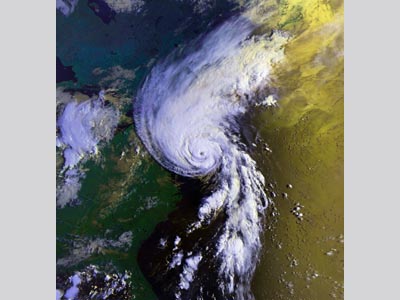African easterly waves were not the primary source of named storms during the 1991 Atlantic hurricane season. Instead, a zone within several hundred kilometers of Bermuda was a “hot spot” for tropical cyclone formation; non-tropical disturbances in this area generated all of the significant tropical cyclones for the year.
Hurricane Bob was one such system, originating from a large area of disturbed weather southeast of Bermuda around August 12, 1991. The system was not declared a tropical depression until early on 16 August, only to be declared a tropical storm 18 hours later that same day. Bob became a hurricane later on 17 August, approximately 379.9 km (236 mi) east of Daytona Beach, FL. The hurricane then began turning toward the north and then north-northeast at an increasing forward speed. A well-defined eye appeared on satellite imagery late on 18 August. The hurricane continued to intensify, and the eye became even more distinct as the storm reached Category 3 strength, passing approximately 56.3 (35 mi) east of Cape Hatteras, NC early on 19 August. Bob continued its parallel movement along the U.S. mid-Atlantic coastline toward New England, but as Atlantic waters became increasingly cooler in advance of the storm, the hurricane weakened. Bob eventually made landfall over Newport, RI, as a Category 2 hurricane with winds of 160.9 km/h (100 mph). Hurricane Bob crossed Rhode Island and Massachusetts, and then the storm’s center passed just offshore the southern coast of Maine, making its final landfall as a tropical storm (with 112.7 km/h [70 mph] winds) near Rockland, ME early on August 20, 1991. Hurricane Bob brought significant, strong winds (133.6- 172.2 km/h [83-107 mph]) to the coastal communities of Rhode Island and most of southeast Massachusetts. Peak wind gusts of 201.2 km/h (125 mph) were recorded on Cape Cod, MA, with the highest sustained winds of 160.9 km/h (100 mph) recorded in the outer Cape village of North Truro, MA. Wind-driven water was funneled into Buzzards Bay, MA and Narragansett Bay, RI, causing a storm surge of 2-5 m (6-15 ft). Significant rainfall fell across New England, with the heaviest amount of rain falling in Portland, ME (209.1 mm [8.2 in]), setting a record for the city. Buzzards Bay and the east coast of Cape Cod were the hardest hit by the storm, where home, boat, and beach damage was significant. Total damage in New England alone was approximately $1.5 billion (in 1991 USD; $2.4 billion in 2009 USD). Fast Facts:
Sources:
Richard J. Pasch and Lixion A. Avila. 1992. Atlantic Hurricane Season of 1991. Monthly Weather Review. 2671-2687 Valiela et al. 1998. Ecological Effects of Major Storms on Coastal Watersheds and Coastal Waters: Hurricane Bob on Cape Cod. Journal of Costal Research. Vol 14 (1): 218-238. Longshore, David. 1998. Great Cyclone of 1970. In: Encyclopedia of hurricanes, typhoons, and cyclones. Facts on File, Inc. New York. Pp. 42-44. |


